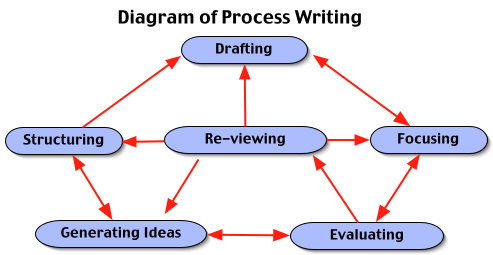 Process
Writing
Process
WritingThe writing process, according to White and Arndt, is a cycle of generating ideas, structuring, drafting, reviewing, focusing, and evaluating (figure 1). As we can see from the directions shown by the arrows, writing is not a linear process (that is, it does not go in a straight line from start to finish), but one which involves a constant cycle of thinking, drafting, and reviewing.

Figure 1. The writing process
The many parts of this process cannot operate at the same time, even if the writer is skilled and the writing task is easy, as this would involve using more information than human short-term memory can hold. Just as a person learning to juggle does not start with a large number of objects of various sizes and shapes, so an ESL/EFL writer cannot simultaneously "juggle" all of the parts of the writing process. There are two ways of solving this problem:
1. making parts of the process automatic so they require little thought (for example, few writers think about the formation of each individual letter, although when they first learned to write they did); 2. using a range of strategies over time which allow the writer to think about each of the important parts of the composing process separately. In order to do this, outline carefully for students the skills involved in each of the stages of the composing process. These skills are best learned in the context of problem-solving writing assignments.
What is involved in each of these sub-processes? According to White and Arndt, the following skills must be mastered within each sub-process.
2. Planning/Generating Ideas
Planning/generating ideas draws from long-term memory, knowledge, experiences, and beliefs all of which are selected and refined according to:
a. the writer's intended meaning, that is, the information the writer wishes to impart to his/her readers;
b. the writer's intended audience, taking into account its knowledge, experience and beliefs;
c. the image of himself/herself the writer wishes to project through the writing, (this image is often called the writer's "voice", for example, an authority on a subject wishing to inform less knowledgeable readers).
A difficulty with long-term memory is retrieving from it the needed information (the "I don't know what to say" complaint), and then adapting this information to fit the demands of the writing task. A composition is more than simply a list of ideas. The writer must arrange these ideas into a composition using forms that are conventional to English and this is what often causes problems for ESL/EFL writers.
White and Arndt divide ways of generating ideas into guided and unguided. “Guided“ ways of generating ideas usually use specific questions to help writers remember ideas or create new ones. For example, the page introducing SPRE/R and Cubing shows two guided ways of generating ideas. Another example of guided ways of generating ideas is Classical Invention. “Unguided” ways of generating ideas do not use prompts, but generate ideas themselves. Brainstorming using freewriting and listing is an unguided way of generating ideas. It can be used to:
All writers must address the challenges above regardless of the language in which we are writing. For ESL/EFL writers, planning is complicated by having to express knowledge, experiences, and beliefs in English.
Focusing means deciding the central idea or the thesis which you want to answer the reader’s question: What are you trying to tell me? Often we do not discover our main idea, or at least what we want to say about our main idea, until we have started writing. When we focus our writing we also reveal our attitude towards the topic about which we are writing. Writing a letter to the editor of a newspaper is a good way of learning to focus our writing.
Suppose you decide to make Smoking the topic of a composition. You could decide to focus on one of the following areas:
While your topic is the same in each case, your focus is different, resulting in very different compositions. Go here for a writing exercise that helps you develop your ability to focus a composition.
Drafting (writing) requires a number of skills:
a. Meaning, that is, writers decide how much information they must state explicitly in the text, how much readers will understand from previous information in the text, and how much they can assume the audience already knows.b. Syntax -- being able to form understandable sentences according to the grammar of English.
c. Word choice -- involving:
- how well the word chosen carries the intended meaning;
- what the audience associates with the word;
- how the word functions in the discourse of the text, that is, is it a key term such as "therefore";
- how the word appeals to the writer's sense of beauty.
d. Physical layout -- i.e. the use of headings, paragraphs, lists, graphs, space, etc.
e. Spelling and punctuation -- must follow the conventions the audience expects.
f. Motor skills -- the actual skills of forming the letters that make up the words.
Student writers often feel that only the teacher is responsible for evaluating writing. However, students leave school or university and no longer have a teacher to look over their shoulder when they write. It is important to develop the skill of evaluating your own writing and not relying only on the opinion of a teacher.
Reviewing or revision means to go back to your writing and try to see it with a new set of eyes: the eyes of a reader who has never seen the text before. Writers re-read what they have already written and evaluate it against their intentions in the planning and transcribing stages. Reviewing is discussed further in the pages on revising.
![]()